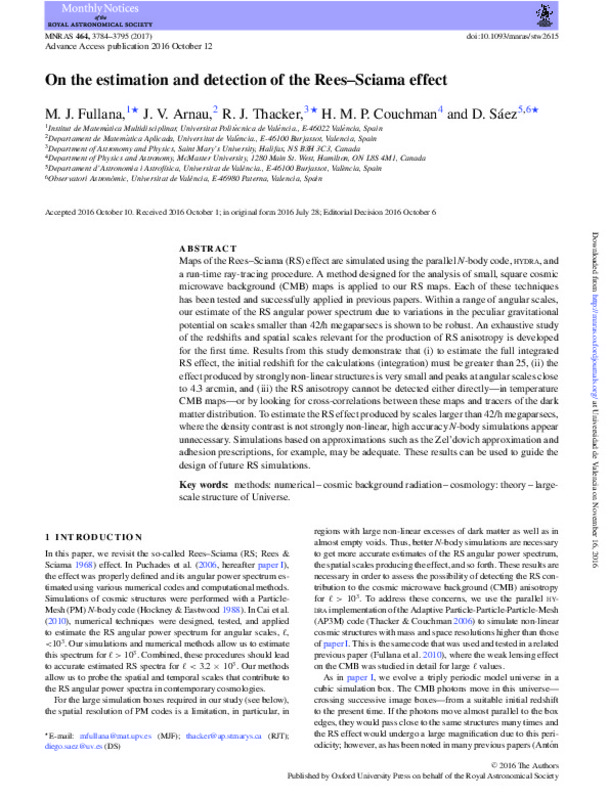JavaScript is disabled for your browser. Some features of this site may not work without it.
Buscar en RiuNet
Listar
Mi cuenta
Estadísticas
Ayuda RiuNet
Admin. UPV
On the estimation and detection of the Rees Sciama effect
Mostrar el registro sencillo del ítem
Ficheros en el ítem
| dc.contributor.author | Fullana Alfonso, Màrius Josep
|
es_ES |
| dc.contributor.author | Arnau, J.V.
|
es_ES |
| dc.contributor.author | Thacker, R.J.
|
es_ES |
| dc.contributor.author | Couchman, H.M.P.
|
es_ES |
| dc.contributor.author | Sáez, D.
|
es_ES |
| dc.date.accessioned | 2017-05-04T15:15:32Z | |
| dc.date.available | 2017-05-04T15:15:32Z | |
| dc.date.issued | 2017-02 | |
| dc.identifier.issn | 0035-8711 | |
| dc.identifier.uri | http://hdl.handle.net/10251/80593 | |
| dc.description | This article has been accepted for publication in: Monthly Notices of the Royal Astronomical Society. ©: 2016 The Authors. Published by Oxford University Press on behalf of the Royal Astronomical Society. All rights reserved. | es_ES |
| dc.description.abstract | Maps of the Rees–Sciama (RS) effect are simulated using the parallel N-body code, hydra, and a run-time ray-tracing procedure. A method designed for the analysis of small, square cosmic microwave background (CMB) maps is applied to our RS maps. Each of these techniques has been tested and successfully applied in previous papers. Within a range of angular scales, our estimate of the RS angular power spectrum due to variations in the peculiar gravitational potential on scales smaller than 42/h megaparsecs is shown to be robust. An exhaustive study of the redshifts and spatial scales relevant for the production of RS anisotropy is developed for the first time. Results from this study demonstrate that (i) to estimate the full integrated RS effect, the initial redshift for the calculations (integration) must be greater than 25, (ii) the effect produced by strongly non-linear structures is very small and peaks at angular scales close to 4.3 arcmin, and (iii) the RS anisotropy cannot be detected either directly—in temperature CMB maps—or by looking for cross-correlations between these maps and tracers of the dark matter distribution. To estimate the RS effect produced by scales larger than 42/h megaparsecs, where the density contrast is not strongly non-linear, high accuracy N-body simulations appear unnecessary. Simulations based on approximations such as the Zel'dovich approximation and adhesion prescriptions, for example, may be adequate. These results can be used to guide the design of future RS simulations. | es_ES |
| dc.description.sponsorship | This work has been supported by the Spanish Ministry of Economia y Competitividad, MICINN-FEDER project FIS2015-64552-P. Calculations were carried out at the Centre de Calcul de la Universitat de Valencia. RJT thanks NSERC, the Canada Research Chairs Program, Canada Foundation for Innovation and the Nova Scotia Research and Innovation Trust for support. HMPC thank NSERC for support. | en_EN |
| dc.language | Inglés | es_ES |
| dc.publisher | Oxford University Press (OUP) | es_ES |
| dc.relation.ispartof | Monthly Notices of the Royal Astronomical Society | es_ES |
| dc.rights | Reserva de todos los derechos | es_ES |
| dc.subject | Methods: numerical | es_ES |
| dc.subject | Cosmic background radiation | es_ES |
| dc.subject | Cosmology: theory | es_ES |
| dc.subject | Large-scale structure of Universe | es_ES |
| dc.subject.classification | MATEMATICA APLICADA | es_ES |
| dc.title | On the estimation and detection of the Rees Sciama effect | es_ES |
| dc.type | Artículo | es_ES |
| dc.identifier.doi | 10.1093/mnras/stw2615 | |
| dc.relation.projectID | info:eu-repo/grantAgreement/MINECO//FIS2015-64552-P/ES/RELATIVIDAD, COSMOLOGIA Y POSICIONAMIENTO/ | es_ES |
| dc.rights.accessRights | Abierto | es_ES |
| dc.contributor.affiliation | Universitat Politècnica de València. Escuela Técnica Superior de Gestión en la Edificación - Escola Tècnica Superior de Gestió en l'Edificació | es_ES |
| dc.description.bibliographicCitation | Fullana Alfonso, MJ.; Arnau, J.; Thacker, R.; Couchman, H.; Sáez, D. (2017). On the estimation and detection of the Rees Sciama effect. Monthly Notices of the Royal Astronomical Society. 464(4):3784-1795. https://doi.org/10.1093/mnras/stw2615 | es_ES |
| dc.description.accrualMethod | S | es_ES |
| dc.relation.publisherversion | https://doi.org/10.1093/mnras/stw2615 | es_ES |
| dc.description.upvformatpinicio | 3784 | es_ES |
| dc.description.upvformatpfin | 1795 | es_ES |
| dc.type.version | info:eu-repo/semantics/publishedVersion | es_ES |
| dc.description.volume | 464 | es_ES |
| dc.description.issue | 4 | es_ES |
| dc.relation.senia | 328434 | es_ES |
| dc.identifier.eissn | 1365-2966 | |
| dc.contributor.funder | Ministerio de Economía y Competitividad | es_ES |
| dc.contributor.funder | Canada Foundation for Innovation | es_ES |
| dc.contributor.funder | Social Sciences and Humanities Research Council of Canada | es_ES |
| dc.contributor.funder | Nova Scotia Research Innovation Trust | es_ES |








